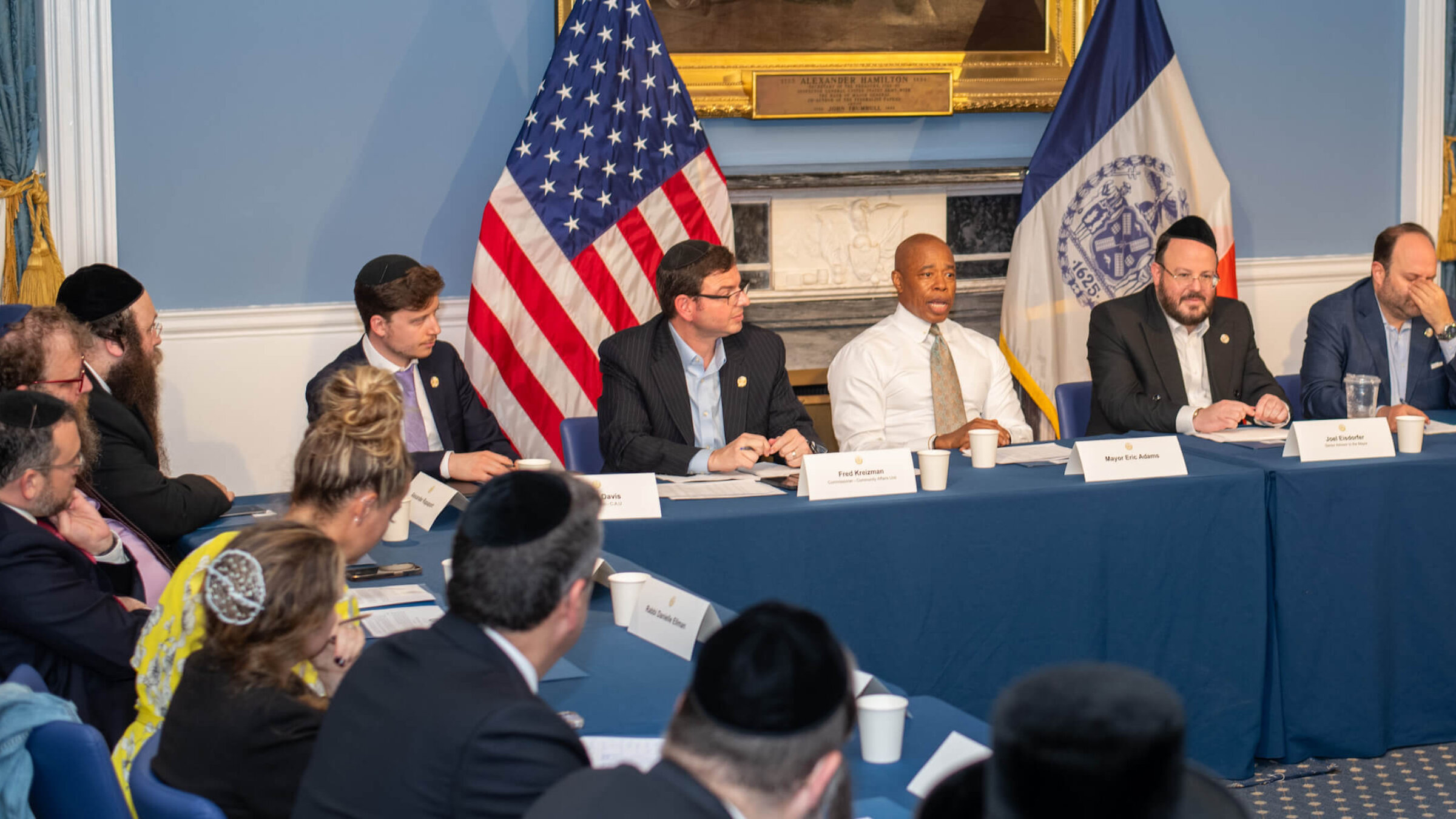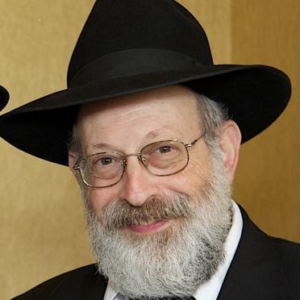The NYC Jewish advisory council appropriately represents Jewish New Yorkers
Given Orthodox Jews bear the brunt of antisemitic attacks, they deserve greater numbers on the council appointed to combat antisemitic crimes

New York City Mayor Eric Adams delivers remarks at the launch and inaugural meeting of his Jewish Advisory Council. City Hall, June 26, 2023. Photo by Benny Polatseck/Mayoral Photography Office
A tempest in a teapot — or, perhaps more aptly, a cyclone in a tchainik — followed the announcement on June 26 of the members of New York City’s first Jewish Advisory Council, a brainchild of Mayor Eric Adams.
A piece in The New York Times noted that “at least 23 members of the 37-member council are Orthodox, and only nine are women,” which “has drawn criticism from a number of prominent Jewish leaders and groups.”
Those critics, including Reform rabbis and other progressive Jewish figures, were upset that there was too little representation of the “archetypical Jewish New Yorker,” the type, as the article felicitously put it, who “might be found on the Upper West Side, somewhere between Zabar’s and Barney Greengrass.”
A cadre of local politicians registered their own chagrin, firing off a letter to the mayor calling him to task for including so many Orthodox men and too few non-Orthodox Jews, women, people of color, and members of the LGBTQ+ community. The politicos were following the lead of Rep. Jerrold Nadler — the House’s most senior Jewish member — who “excoriated” Adams, according to the Times, for failing to “adequately represent the demographic diversity of Jewish New Yorkers.”
As someone who regularly speaks on behalf of the Orthodox community and the importance of their representation, I sympathize with any concern over adequate representation. All Jews deserve to have their concerns heard. However, there is some unpacking to do here over why the makeup of the council is the way it is, and, in my view, an appropriate representation of Jewish New Yorkers.
Adams formed the Jewish Advisory Council primarily in response to an abundance of Big Apple worms, in the form of antisemitic attacks. New York City saw a 39% increase in hate crimes targeting Jews in 2022, compared to the previous year, according to the Anti-Defamation League.
I’m a pretty typical visibly Orthodox Jew, and I wish I had a dollar for every time I have been assaulted or harangued because of my Jewish identity — most recently just a few weeks ago on the Staten Island Ferry — by a total stranger.
Editor’s note: The executive vice president of Agudath Israel is a member of the advisory council. The author works as Agudath Israel’s director of public affairs, but is writing in his personal capacity.
It should be clear to any New Yorker that the victims of antisemitic physical and verbal attacks that have taken place over recent years have largely been Orthodox Jews. That is to say, Jews who are noticeably Jewish, so identified by their garb and headgear. The ADL reports that Orthodox Jews were the victims of 64% of assault incidents in New York state in 2022. The city statistic is undoubtedly even higher.
In Adams’ words, included in the official announcement of the council on June 26: “With antisemitic crimes up across the nation, our newly formed Jewish Advisory Council will ensure that Jewish New Yorkers in every community have a seat at the table and have access to the support and resources the city offers.”
A secondary task of the council, the mayor noted, was to assist “the city’s government on dealing with sensitive issues like education in the Jewish community,” referring to the allegations that Orthodox yeshivas are not satisfying the state’s secular requirements. Therefore, it’s hardly surprising that the mayor wanted significant Orthodox communal representation in the room to speak with about the very issues for which he founded the advisory board.
But there’s something else here, too. In the corner of the room that I imagine inhabited by all those outraged at the council’s composition lurks an elephant. And it’s wearing a black hat.
It’s always disconcerting when a neighborhood evolves. I recall how, eons ago, when I was a pre-bar mitzvah boy growing up in Baltimore, the composition of my lower-middle-class environment shifted from largely Jewish to largely non-Jewish residents. My parents bore no animus toward the newcomers, and I and my brother made friends with the new neighbor boys. But seeing the neighborhood morph from its Jewish character wasn’t easy — change of any kind is challenging.
Therefore, it may be a challenging time for Jewish New Yorkers who express their Jewishness in a largely cultural or political way who, looking around, increasingly see more “old country”-looking, observant Jews in their neighborhoods than they remember in times past.
I do not judge any fellow Jew who expresses their Jewishness as a dedication to Jewish culture, or to liberal or progressive politics. I simply happen to believe, like all Orthodox Jews, that Judaism asks Jews to observe Judaism as the Torah commands, as it has been practiced for millennia. For those who do not share that belief, our religiosity can be perceived as a threat.
I understand their fear. Of the 600,000 Jews living in Brooklyn, more than 300,000 are Orthodox. Manhattan, long the turf of — to borrow the Times’ characterization — the “Zabar’s and Barney Greengrass” crowd, also has a substantial Orthodox presence.
The New York Times reported — in 2012 — that fully 40 percent of Jews in the entire city identify themselves as Orthodox (an increase from 33 percent in 2002). And that 74 percent of all Jewish children in the city are Orthodox. More than a decade later, those percentages have likely grown further.
On a national scale, within two generations, the Orthodox fraction of the American Jewish population has more than quintupled. More than a quarter of American Jews 17 years old or younger, moreover, are Orthodox. Public policy experts Eric Cohen and Aylana Meisel estimate that, by 2050, the American Jewish community will be majority Orthodox.
Additionally, the Orthodox Jewish emphasis on bringing new Jews into the world yields an average birth rate in the American Orthodox world of 3.3, while the rest of the Jewish community’s rate is below replacement level at 1.5.
Perhaps the image of an abundance of visibly Orthodox Jews around a table with Mayor Adams makes some less-observant Jews anxious. It is a visible reminder of the increased and increasing demographic strength of the Orthodox community in New York City.
But reality is reality. The Orthodox community is growing and, like any community, advocates its interests and interacts with public officials.
To be sure, there are societal issues where Orthodox and non-Orthodox Jews may strongly disagree. What is needed now is outreach and dialogue, not fear and umbrage-taking. I believe that reasoned, responsible members of the Orthodox community understand and can appreciate the concerns and positions of their non-Orthodox fellow Jews, even if they don’t share them.
I have faith that the entire Jewish community of New York City will benefit if reasoned, responsible members of the non-Orthodox part of Klal Yisrael will try to better understand us, not fear us.
To contact the author, email [email protected].























